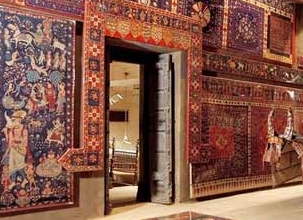Calico Museum of Textiles

The Calico Museum of Textiles is located in the city of Ahmedabad in the
state of Gujarat in western India.The museum is managed by the Sarabhai
Foundation and is one of the most popular tourist attractions in Ahmedabad.
History
The museum was founded in 1949 by the industrialist Gautam Sarabhai and his
sister Gira Sarabhai. Ahmedabad at that time had a flourishing textile
industry. The museum was originally housed at the Calico Mills in the heart
of the textile industry. But as the collection grew the museum was shifted
to the Sarabhai House in Shahibaug.
The Story of the Calico Museum
The Calico Museum of Textile, only thirty-one years old, is today justly
regarded as one among the foremost textile museums in the world and an
important Indian institution. Its outstanding collection of Indian fabrics
exemplifies handicraft textiles spanning five centuries and attracts large
numbers of visitors from the general public, as well as increasing numbers
of Indian and international research scholars. Most significant, it has
become a major reference area for our surviving handicraftsmen and also for
the Indian machine-textile industry.
The Museum was inspired by Dr. Ananda Coomaraswamy, who, in conversations
with Shri Gautam Sarabhai during the 1940s, suggested the founding of a
textile institute in the city of Ahmedabad, a major trading centre of the
textile industry of the sub-continent since the fifteenth century. In 1949
Shri Sarabhai, his sister Gira Sarabhai and the great industrial house of
Calico acted on this suggestion, founding the Calico Museum of Textiles in
Ahmedabad, as the specialist museum in India concerned with both the
historical and technical study of Indian handicraft and industrial textiles.
By the early fifties the Museum discovered its original intent, encompassed
too large an area and concentrated its energies on the vast and vital field
of handicraft textiles, devoting less and less time to industrial fabrics.By
the second decade of its existence the Museum launched an ambitious
publications programme. The programme worked on two series, namely
Historical Textiles Of India under the editorship of John Irwin, then keeper
of the Indian Section of the Victoria and Albert Museum; and the second,
under the editorial direction of Dr Alfred Bühler, fümer Director of the
Museum Für Volkerkunde Und Schweizerisches Museum Für Volkskunde, Basel, who
conducted a Contemporary Textile Craft Survey of India
Inaugurating the Museum in 1949, Jawaharlal Nehru stated, "The early
beginnings of civilization are tied up with the manufacture of textiles, and
history might well be written with this as the leading motif." And indeed,
so well had the Calico Museum of Textiles fulfilled this brief that by 1971
the House of Calico decided that the excellence of the fabric collection and
the invaluable research conducted by the publications department were such
that the Museum should be an independent society.
That the Museum was able to accomplish the transition to an independent
entity was due in large part to the enlightened administration by Gautam and
Gira Sarabhai. From its very inception in 1949 the Museum was able to draw
not only on their knowledge but also on their wide reputation as
connoisseurs of the arts, which drew to the Museum scholars and
administrators of international and national eminence such as John Irwin,
Alfred Bühler, Moti Chandra and its present Chairman, Pupul Jayakar. With
such outstanding talent to guide it, the Calico Museum of Textiles in its
three decades of existence has been able to create and sustain a
consistently high level not merely of scholarship but of excellence in all
the many technical fields required to run a museum of this nature-acquiring
the services of craftsmen, designers, artists, carpenters, tailors, lighting
experts, etc.
The sustained funding by the Calico Group, despite the independence of the
Museum Society, has allowed the Museum to grow both in volume and stature.
The Museum’s publications, which have now taken two distinct directions,
give some indication of where the next surge of activity will take place.
While the number of publications concerned with historical studies continues
and increases, the second direction has resulted in research and publication
of studies preoccupied with the technical and scientific examinations of
textile processes such as looms, dyeing, printing techniques, etc.
Textile Collection
The textiles on display include court textiles used by the Mughal and
provincial rulers of 15th to 19th centuries. Also on display are regional
embroideries of the 19th century, tie-dyed textiles and religious textiles.
The galleries also have exhibits on ritual art and sculpture, temple
hangings, miniature paintings, South Indian bronzes, Jain art and sculpture,
and furniture and crafts. There are also textile techniques galleries and a
library. The museum has played an important role in determining the
curriculum taught in the textile designing courses at the prestigious
National Institute of Design also located in Ahmedabad.
The items on display are well protected by the museum authorities. The
textile are protected from dust, air pollution and fluctuations in
temperatures by the trees around the museum complex. The relative humidity
inside the museum is also controlled and lights are dimmed between visiting
hours to extend the life of the textiles.
undo ...back